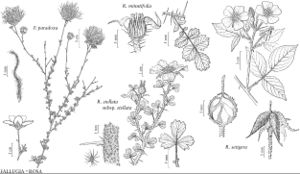Rosa minutifolia
Bull. Torrey Bot. Club 9: 97. 1882.
Shrubs forming dense, low thickets. Stems usually erect, (3–)5–12(–15) dm; distal branches pubescent or glabrous, without stellate hairs; infrastipular prickles absent, internodal prickles sparse to common, erect, (2–)6–10(–12) × 1–3 mm, pubescent at least basally, mixed with dense aciculi, to 3 mm. Leaves 1.5–2.5 cm; stipules 3.5–4 × 1.5–2 mm, margins entire or dentate with glands, surfaces pubescent, eglandular, auricles acute, (0.5–)2–3 mm, surfaces pubescent, eglandular; petiole and rachis puberulent, stipitate glands and pricklets sparse; leaflets 5–7, terminal: petiolule 1–4 mm, blade oval, suborbiculate, or obovate, 3–7 × 2–6 mm, margins deeply 1- or multi-lobed, usually glandular, teeth lobelike, (3 or)4 or 5(or 6) per side on distal 1/2 of blades, some multi-serrate, apex acute to obtuse, abaxial surfaces pubescent (especially on veins), adaxial dull, sometimes pubescent. Inflorescences 1(–3)-flowered. Pedicels 2–9 mm, setae sparse, eglandular; bracts 1 or 2. Flowers 2.5–3 cm diam.; hypanthium subglobose to globose, 3–4 × 2.5–3.5 mm, densely pubescent and setose; sepals spreading, 8–12 × 2–4 mm, tip 4–6 × 1–1.5 mm, lobes 3–4, margins usually gland-tipped, abaxial surfaces pubescent, setae sparse, eglandular or sparsely glandular; petals usually pink to light rose pink, sometimes white, 10–15(–20) × 9–14 mm; stamens 45; carpels 10–25(–30), styles exsert 1–2 mm beyond stylar orifice (2–4 mm diam.), rims 0.5–0.8 mm wide. Hips dark reddish purple, subglobose, 5–7 × 5–7 mm, setae 1–4 mm, pubescent, eglandular. Achenes 6–16, dark, ± terete-elongate, 3.5–4 × 1.5–2 mm. 2n = 14.
Phenology: Flowering Mar–Jul.
Habitat: Dry washes, brush, grasslands, sagebrush, rocky hillsides
Elevation: 0–200 m
Distribution

Calif., Mexico (Baja California).
Discussion
Of conservation concern.
Rosa minutifolia was first collected in the United States in 1985 (San Diego County; G. A. Levin 1986). Before being extirpated by a development project, the single population was re-established in a nearby protected site, where the transplants are reportedly doing well (C. Burrascano, pers. comm.). Existence of R. minutifolia in the United States remains of conservation concern. Although common where found in coastal scrub of Baja California, Mexico, the habitat there is considered threatened by development.
Selected References
None.
